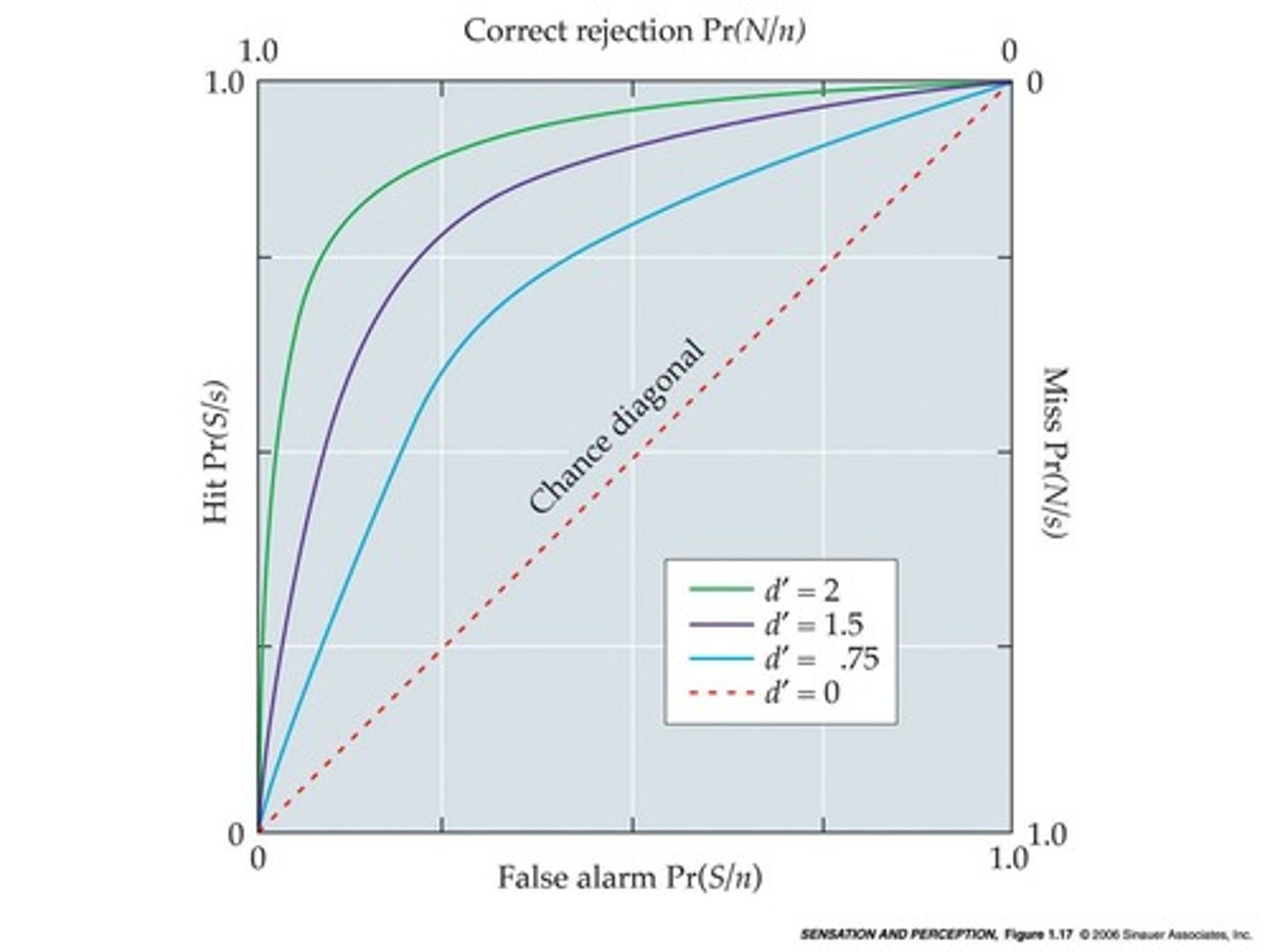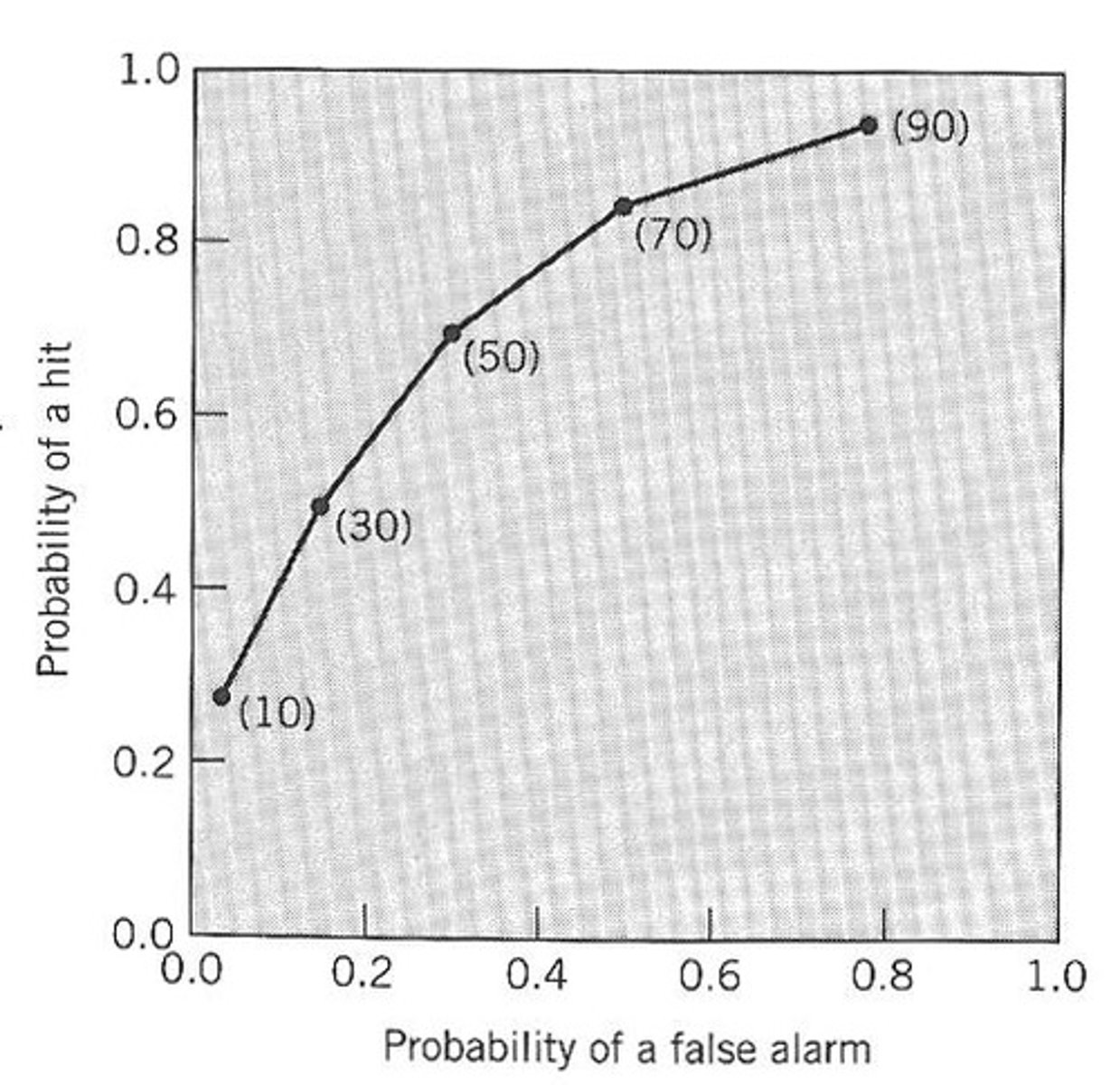Introduction to Perception and Psychophysics: Sensation, Thresholds, and Signal Detection
1/47
There's no tags or description
Looks like no tags are added yet.
Name | Mastery | Learn | Test | Matching | Spaced |
|---|
No study sessions yet.
48 Terms
What is sensation?
The registration of environmental stimuli by sensory organs (eyes, ears, etc.).
What is perception?
The organization and interpretation of signals sent to the brain by the sensory organs.
How does the perceptual world differ from the physical world?
The perceptual world does not equal the physical world; our perceptions are only symbols of the 'real' world.
What is an example of a sensory system that differs among species?
Bees can see ultraviolet light, which humans cannot.
What is adaptation in the context of perception?
A reduction in response caused by prior or continuing stimulation.
What did Heraclitus mean by 'You can never step into the same river twice'?
It reflects the idea that everything is always changing and perceivers cannot perceive the same event in exactly the same manner each time.
What is sensory transduction?
The conversion of physical energy (e.g., light) into neural energy by sensory receptors.
What are primary qualities in perception?
Directly perceived qualities such as weight and texture.
What are secondary qualities in perception?
Qualities that require contact with atoms thrown off by objects, such as vision and hearing.
What is dualism in the context of perception?
The belief that the mind and brain are separable entities, which interact to create perception.
What does Democritus's view on perception entail?
He believed that the world is made up of atoms that collide with one another, causing sensations when they make contact with our sense organs.
How do dogs and cats differ in their sensory abilities compared to humans?
Dogs and cats can sense sounds with higher frequencies than humans can.
What is the significance of the phrase 'What IS real?' in relation to perception?
It questions the nature of reality and how our perceptions may differ from actual physical properties.
What role do sensory fibers play in perception?
They are our only link to the environment, conveying sensory information to the brain.
How do elephants communicate using their sensory abilities?
They can hear very low-frequency sounds, which are used for communication.
What is a key implication of dualism regarding perception?
It implies cause-and-effect relationships between fundamentally different entities (mind and brain).
What does the phrase 'the brain is interested in change' imply about perception?
It suggests that our brains adapt to changes in stimuli rather than responding to constant stimuli.
What is the materialist view of perception?
Perception is a direct product of the nervous system, where both brain and mind are made of the same matter, explained by physical principles.
What does empiricism state about knowledge?
Empiricism asserts that experience and observation from the senses are the only sources of knowledge.
Who proposed that the brain is a 'tabula rasa'?
John Locke proposed that the brain is a 'tabula rasa' (blank slate) on which experience writes.
What was Berkeley's conclusion about perception?
Berkeley concluded that all knowledge about the world must come from experience, regardless of the limitations of perception.
What is bottom-up processing?
Bottom-up processing starts with a stimulus at the sensory organ and is driven by the stimulus itself.
What is top-down processing?
Top-down processing begins in the brain and is influenced by memory, expectations, attention, and motivation.
What does the doctrine of specific nerve energies state?
The doctrine states that the nature of a sensation depends on which sensory fibers are stimulated, not on how they are stimulated.
What is psychophysics?
Psychophysics is the study of how stimulus properties relate to conscious perception, pioneered by Gustav Fechner.
What is the absolute threshold?
The absolute threshold is the minimum stimulus intensity needed for an organism to detect its presence.
What is a sub-threshold stimulus?
A sub-threshold stimulus is one that is not detectable or perceivable.
What is a supra-threshold stimulus?
A supra-threshold stimulus is one that is detectable and perceivable.
What is the method of limits in psychophysics?
The method of limits involves starting with a detectable stimulus and gradually reducing its intensity until it is no longer detected.
What is the method of constant stimuli?
The method of constant stimuli presents stimuli of different intensities randomly, requiring the observer to decide if the stimulus was present.
What is the method of adjustment in psychophysics?
The method of adjustment allows the observer to adjust the stimulus intensity to the just detectable level.
What are the problems associated with determining an absolute threshold?
There appears to be no definitive 'absolute threshold' and observer bias may affect results.
What does it mean when perception is described as constructive?
It means that perception involves making inferences, and the brain can 'hallucinate' reality based on sensory input.
What does Signal Detection Theory (SDT) state about thresholds?
Thresholds are not absolute; they vary depending on signal detectability and observer sensitivity.
What factors can affect sensitivity in Signal Detection Theory?
Non-sensory factors such as attention, motivation, and expectations, collectively known as response bias.
What is the primary task in Signal Detection Theory?
To detect whether or not a signal is present, typically through a forced-choice task.
What is 'noise' in the context of Signal Detection Theory?
Sensory activity not related to the signal, which influences whether the signal is detected.
What is the criterion (β) in Signal Detection Theory?
The level of sensory activity above which the observer indicates that a signal is present.
What are Type I and Type II errors in Signal Detection Theory?
Type I error is a false alarm; Type II error is a miss. They are related to the null hypothesis of no difference between groups.
What does a liberal response bias indicate?
A tendency to say 'yes' more often, regardless of whether the signal is present or not.
What does a conservative response bias indicate?
A tendency to say 'no' more often, requiring stronger evidence to indicate a signal is present.
What are Receiver Operating Characteristic (ROC) curves used for?
They graphically represent the proportion of hits versus false alarms as a function of stimulus probability.

What does d' (d-prime) measure in Signal Detection Theory?
Observer sensitivity, indicated by the curvature of the ROC curve.

What is the Just Noticeable Difference (JND)?
The smallest detectable difference between two stimuli or the minimum change in a stimulus that can be correctly judged as different.
What does Fechner's Law describe?
The relationship between stimulus magnitude and resulting sensation magnitude, stating that sensation increases proportionally to the logarithm of stimulus intensity.
What is Stevens' Power Law?
A principle stating that sensation magnitude is proportional to the stimulus magnitude raised to an exponent.
How does stimulus intensity affect the Just Noticeable Difference?
Higher stimulus intensity requires a larger difference to be noticed.
pro